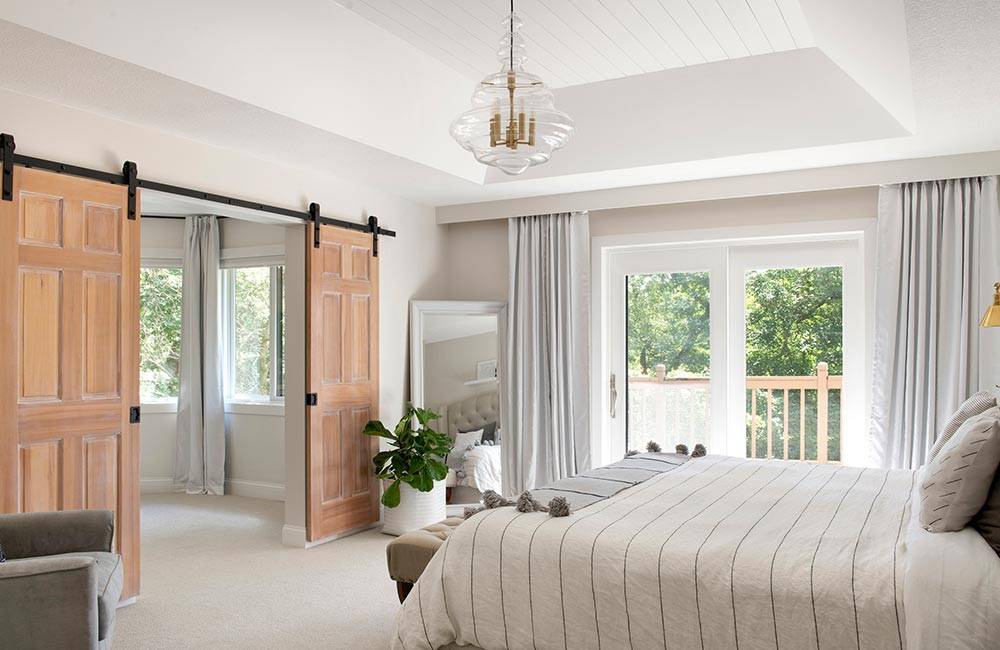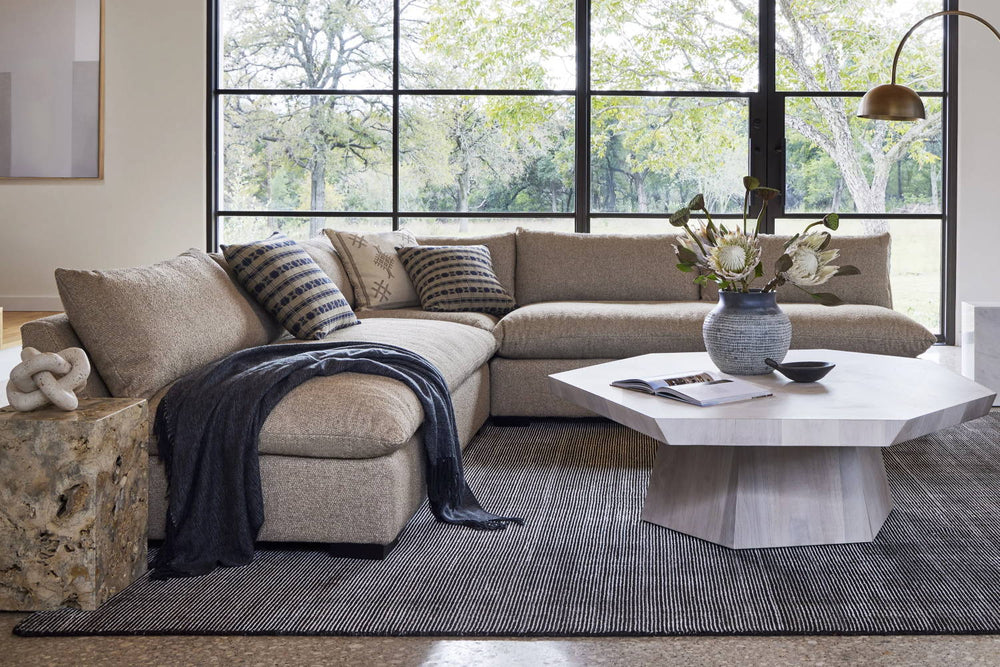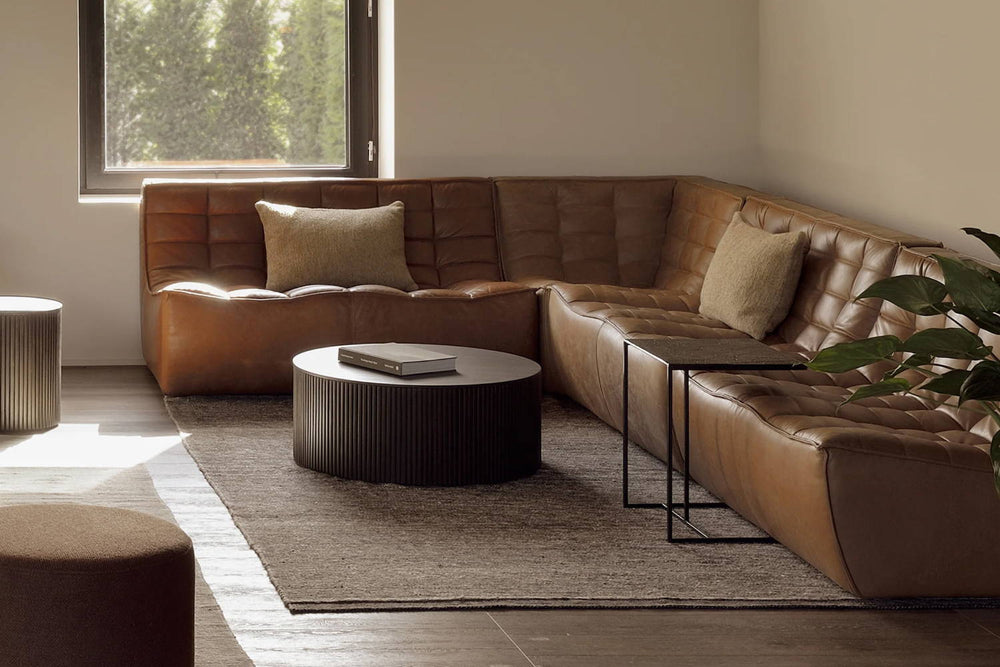Snaregade Round Table by Audo Copenhagen
Choosing the right rug for your dining area is essential not only for enhancing the aesthetic appeal of your space but also for practical reasons. A well-fitted rug can define the dining area, add warmth and comfort, and protect your floors. When it comes to round dining tables, there are unique considerations to take into account to ensure the perfect balance between form and function. In this guide, we'll explore the factors that influence rug size selection, offer tips on measuring your space, and provide design inspiration to help you make the right choice for your round dining table. Whether you're striving for a cozy and intimate dining atmosphere or seeking to create a striking focal point, we've got you covered.
Androgyne Dining Table by Audo Copenhagen
Sizing A Rug for Round Dining Tables
Sizing a rug for round dining tables involves careful consideration of both the table's dimensions and the surrounding space. Here's a step-by-step guide to help you select the perfect rug size:
- Measure Your Round Dining Table: Start by measuring the diameter of your round dining table. Measure from the farthest point on one side to the farthest point on the other side. This measurement will help determine the minimum size for your rug
- Allow for Chair Clearance: To ensure that chairs can comfortably slide in and out without catching on the edge of the rug, you should leave at least 24 to 36 inches of rug space beyond the edges of the table. This provides room for both seated and pulled-out chairs
-
Determine Rug Size: The ideal rug size will depend on the size of your dining table and the clearance you've allowed for chairs. Here are some common guidelines:
- For a 4-foot round table, a rug with a diameter of 6 to 8 feet is typically sufficient
- For a 5-foot round table, a rug with a diameter of 7 to 9 feet works well
- For a 6-foot round table, consider a rug with a diameter of 8 to 10 feet
- Larger tables may require rugs with diameters of 10 feet or more
- Visual Balance: Consider the visual balance of the room. A larger rug can make the dining area feel cozier, while a smaller rug can create a more spacious look. Ensure that the rug provides a visual frame for the dining space without overwhelming it
- Rug Shape: Round rugs are the most common choice for round dining tables as they complement the shape of the table. However, you can also consider a square rug under a round table for a unique and striking look. Just make sure it's large enough to accommodate both the table and chairs
Remember that these are general guidelines, and personal preferences and the specific layout of your dining area can influence your choice. The key is to strike a balance between functionality and aesthetics, ensuring that your dining area feels welcoming and well-proportioned.
Cleo Round Dining Table Glass Top by Saloom Furniture
Rug Sizing Guide for Different Round Table Sizes
Calculating the best rug size for a round dining table involves a simple process that ensures the rug accommodates both the table and chairs while creating an aesthetically pleasing and functional dining area:
- Measure the Diameter of the Round Table: Start by measuring the diameter of your contemporary round dining table. Measure from the farthest point on one side to the farthest point on the opposite side. For example, if your table is 5 feet in diameter, this measurement is 5 feet
-
Calculate the Rug Size for Chair Clearance: To determine the ideal rug size, you need to factor in chair clearance around the table. The minimum recommended clearance is typically 24 to 36 inches from the edge of the table to the edge of the rug. Here's the formula:
Rug Diameter = Table Diameter + (2 x Chair Clearance)- For a 5-foot round table and 24 inches of chair clearance, the rug diameter would be: Rug Diameter = 5 feet (table diameter) + 2 x 2 feet (chair clearance) = 9 feet rug diameter
- For a 5-foot round table and 36 inches of chair clearance, the rug diameter would be: Rug Diameter = 5 feet (table diameter) + 2 x 3 feet (chair clearance) = 11 feet rug diameter
- Visual Balance: While the calculated rug diameter is a good starting point, consider the overall visual balance and aesthetics of the room. Depending on the space and your preferences, you may opt for a slightly larger or smaller rug
- Testing It Out: Before making a final decision, use painter's tape to mark the dimensions of the calculated rug size on your floor. This visual guide will help you determine if the size and placement look and feel right in your dining area
Keep in mind that these are guidelines, and personal preferences, room size, and layout can influence your choice. The key is to create a harmonious dining space that is both visually appealing and functional, with enough room for chairs to move comfortably.
Plastic River Niger Round Rug by GAN Rugs
Rules of Thumb for Round Rugs
Round rugs are an excellent choice for round dining tables for several reasons:
- Complementing Shapes: Round rugs echo the shape of the table, creating a sense of symmetry and harmony. This visual continuity between the rug and the table enhances the overall aesthetic appeal of the dining area. However, you can also consider a square rug under a round table or a larger round rug for a unique look
- Focal Point: A round rug positioned beneath a round dining table naturally draws attention to the center of the room. It can serve as a captivating focal point, especially when paired with well-chosen decor elements
- Defining the Space: Round rugs help define and delineate the dining space within an open-concept room. They create a clear boundary for the dining area, making it feel separate and cozy
- Flow and Balance: The circular shape of the rug complements the rounded edges of the table. This results in a pleasing flow and balance in the room, avoiding the clash that can sometimes occur when rectangular rugs are placed under round tables
- Facilitating Movement: Round rugs allow chairs to move smoothly without catching on the corners of the rug. This practical aspect is essential for ease of use and comfort during meals
- Conversation-Friendly: The circular arrangement of the dining table and chairs on a round rug promotes more natural and comfortable conversation among diners. Everyone at the table can easily see and engage with one another
- Versatility: Round rugs are versatile and can be used in various interior design styles, from traditional to modern and eclectic. Their soft lines and curves make them a flexible choice that can adapt to different decor themes
- Space Efficiency: Contemporary round rugs are particularly space-efficient. They fit neatly under the round table without excess material extending beyond the table's edges, creating a streamlined and uncluttered look
- Cozy Atmosphere: The circular shape of both the rug and the table can create a warm and inviting atmosphere. This is especially beneficial for smaller dining areas, making them feel more intimate
- Aesthetic Variety: While a simple, solid-color round rug can be a classic choice, round rugs come in a variety of designs, patterns, and textures. This allows you to choose a rug that complements your decor and adds character to the dining space
In summary, round rugs are well-suited for round dining tables due to their aesthetic and practical advantages. They help create a visually appealing, well-balanced, and functional dining area while adding an inviting and cohesive element to your room's design.
Four Table by Kartell
Rug Size Recommendations for Square & Rectangular Tables
Selecting the best rug size for square and rectangular dining tables of various sizes involves considering the table's dimensions and the number of seats it accommodates. Here are recommended rug sizes for different table sizes:
-
Square Table (36-44 inches):
- For a square table with a side length of 36 to 44 inches, consider a rug that is at least 6 x 6 feet (72 x 72 inches). This size accommodates the table and chairs while providing room for movement
-
Square Table (48-54 inches):
- For a larger square table with a side length of 48 to 54 inches, opt for a rug that is at least 8 x 8 feet (96 x 96 inches). This size allows space for the table and chairs and provides ample clearance
-
Rectangular Table (48-60 inches long):
- For a small to medium rectangular table with a length of 48 to 60 inches, select a rug that is at least 6 x 9 feet (72 x 108 inches). This accommodates the table and chairs with ample clearance
-
Rectangular Table (60-72 inches long):
- For a larger rectangular table with a length of 60 to 72 inches, a rug that measures 8 x 10 feet (96 x 120 inches) or larger is recommended. This size creates a balanced and spacious dining area
-
Rectangular Table (72-96 inches long):
- For a long rectangular table with a length of 72 to 96 inches, consider a rug that is 8 x 10 feet (96 x 120 inches) or larger, depending on the available space and the number of chairs
Remember that these are general guidelines, and personal preferences, room size, and layout can influence your choice. It's also essential to allow for sufficient chair clearance (usually 24-36 inches) around all sides of the table to ensure that chairs can be pulled out and pushed in comfortably. Testing out the rug's size and placement using painter's tape or a mock rug can be helpful to visualize how it fits in your dining area.
Earth Natural Rug by Massimo Copenhagen
Additional Rug Selection Considerations
Material:
Selecting the right rug material for your dining room is crucial because dining rooms are often high-traffic areas that can be prone to spills and messes. You'll want a rug material that combines durability, ease of maintenance, and aesthetic appeal. Here are some common rug materials to consider:
- Wool: Wool is a popular choice for dining room rugs. It's durable, naturally stain-resistant, and easy to clean. Wool rugs are soft underfoot, making them comfortable for both casual and formal dining. They also have good insulation properties, helping to maintain a comfortable temperature in the room
- Synthetic Fibers (Polyester, Nylon, Polypropylene): Synthetic rugs are known for their durability and resistance to stains. They are often more affordable than natural fibers and come in a wide range of styles and colors. Polyester and polypropylene are particularly stain-resistant, making them suitable for dining rooms
- Cotton: Cotton rugs are easy to clean and maintain. They are affordable and come in various colors and patterns, making it easy to find one that complements your dining room decor. However, they may not be as stain-resistant as some other materials
- Sisal and Seagrass: These natural fibers are incredibly durable, making them a good choice for high-traffic areas like dining rooms. They have a textured appearance that can add a rustic or casual feel to the space. Keep in mind that they are not as soft underfoot as wool or synthetic materials
- Jute: Jute rugs are another natural fiber option. They are affordable and add a natural and organic touch to your dining room. However, they can be less stain-resistant and more challenging to clean compared to some other material
Shape:
- Rectangular Table: For a rectangular dining table, a rectangular rug is the most common choice. It mirrors the table's shape, creating a balanced and symmetrical look
- Square Table: If you have a square dining table, a square rug works well to maintain symmetry. It reinforces the table's shape and creates a cohesive appearance
- Round Table: For a round dining table, a round rug is a natural fit. The circular rug complements the table's shape and enhances the room's visual harmony
-
Shape Contrast: In some cases, choosing a rug with a different shape than your table can create a striking visual contrast. For example:
- A square rug under a round table can create a captivating and unexpected focal point
- A round rug under a rectangular table can soften the room's lines and add a touch of whimsy
- Room Layout: Consider the layout of the dining area within the room. The shape of the rug should define and anchor the dining space. Ensure that the rug extends beyond the table and chairs to provide ample space for chair movement
- Proportion: Take into account the size of the dining area and the proportion of the rug to the space. In larger dining rooms, a larger rug can create a more substantial and comfortable look. Smaller spaces may benefit from a smaller rug to avoid overwhelming the room
Color:
Start by looking at the existing colors in your dining room. Take note of the wall paint, furniture, and decor. Choose a rug color that harmonizes with these existing elements.
- Neutral Colors: Neutral rug colors like beige, gray, ivory, and taupe are versatile choices. They work well in a wide range of dining room styles and can complement almost any color scheme. Neutrals provide a timeless and elegant look
-
Match or Complement the Dining Table: The rug color can either match the dining table or complement it. For example:
- If you have a wood dining table, you can choose a rug that matches the wood tone to create a cohesive and harmonious look
- If your dining table is a solid color, you can use a rug that complements the table's color while adding contrast or visual interest
- Contrast for Visual Impact: Consider using a rug with a contrasting color to create a visual focal point in the room. For instance, a bold-colored rug under a neutral-toned dining table can make a striking statement
- Dining Chair Upholstery: Take into account the color of your dining chairs. A rug that complements the chair upholstery can tie the entire room together
- Practicality: Keep in mind that dining areas are prone to spills and stains. If you're concerned about visible stains, opt for a rug with a pattern or a mix of colors, as it can help hide small stains and spills
- Patterned Rugs: If you prefer a rug with patterns, ensure that the colors in the pattern coordinate with your dining room's color scheme. The rug's pattern should enhance the room's aesthetics, not overwhelm it
The Crochet Trio Mix Rug by GAN Rugs
Selecting the right rug size for round dining tables is a key element in creating a well-balanced and inviting dining space. The size and shape of the rug should harmonize with the table, chairs, and room, while considering both aesthetics and practicality. By measuring your table, allowing for chair clearance, and choosing the appropriate rug shape, you can ensure that your dining area feels cohesive and functional. Whether you opt for a round rug that mirrors the table's shape or decide on a contrasting shape for added visual interest, the goal is to strike a balance between form and function. Remember that your rug choice should also reflect your personal style and room decor. The right rug can define the dining area, enhance the room's aesthetics, and provide a comfortable and visually pleasing setting for your meals and gatherings.








